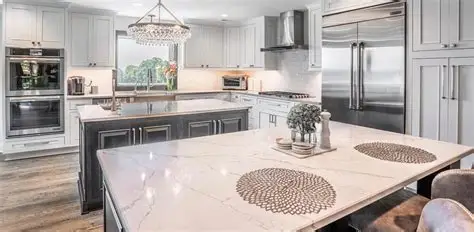Quartz countertops have surged in popularity as a stylish and practical choice for both kitchens and bathrooms. Whether you’re working with white quartz countertops, veined quartz countertops, or Calacatta quartz countertops, quartz delivers durability, beauty, and versatility.
But what if you need to cut prefabricated quartz slabs yourself? Cutting prefab quartz countertops isn’t just about slicing through stone—it requires the right tools, techniques, and safety precautions. This guide will walk you through everything you need to know about cutting quartz countertops like a pro.

What Are Quartz Countertops Made Of?
Before diving into cutting methods, it’s important to understand the material. What Are Quartz Countertops?
Quartz countertops are engineered stone countertops—made from approximately 90–95% ground natural quartz, mixed with polymers and resins. This creates a non-porous, heat-resistant, and hard surface that is tough but not invincible.
Prefab quartz slabs typically come pre-cut with finished edges but may require trimming to fit your layout precisely.

Tools & Equipment for Cutting Quartz Countertops
Cutting quartz kitchen countertops or quartz bathroom countertops requires specialized tools to ensure clean cuts without damaging the material:
- Circular Saw with a diamond blade
- Clamps to secure the slab
- Measuring tape and straightedge
- Masking tape (to reduce chipping)
- Safety gear (goggles, mask, gloves, ear protection)
- Wet saw or angle grinder (for curved or detailed cuts)
- Vacuum or shop vac (to minimize dust)
For safe handling of heavy slabs, consider using Material handling equipment such as vacuum lifters or slab carts.
Step-by-Step Instructions to Cut Prefab Quartz Countertops
Step 1: Measure and Mark Your Cut Lines
- Measure your cabinetry, appliances, or sink cutouts precisely.
- Use a pencil and straightedge to mark your cutting lines on the protective film of the countertop.
- Double-check measurements—measure twice, cut once.
Step 2: Secure the Slab
- Place the quartz slab on a stable workbench or support structure.
- Use clamps to hold it in place.
- Position the slab so that the area you plan to cut extends beyond the work surface.
Step 3: Apply Masking Tape
- Apply masking tape along the cutting line.
- This minimizes chipping and helps you see the cut more clearly.
Step 4: Make the Cut with a Diamond Blade
- Use a circular saw with a diamond blade specifically made for stone cutting.
- Start the saw before contacting the slab, and move slowly and steadily along the marked line.
- Use water if possible (with a wet saw) to reduce dust and overheating.
Safety Tip: Always wear protective gear and cut in a well-ventilated space. Quartz dust can be harmful if inhaled.
Making Curved Cuts or Sink Cutouts
For sink cutouts or other rounded shapes:
- Drill pilot holes in each corner using a diamond-tipped drill bit.
- Use a jigsaw with a diamond blade or an angle grinder to connect the holes and finish the cut.
These are especially common in quartz slabs for countertops that accommodate undermount sinks or drop-ins.
Finishing the Edges
After cutting, the edges may appear rough or slightly chipped.
- Use diamond hand pads or polishing pads starting with coarse grit and progressing to finer grits.
- Smooth out edges until they resemble the factory finish.
This process is essential for DIY quartz countertop installation tips and ensures your cut edge matches the rest of your budget quartz countertops or custom quartz countertop installers’ work.
Common Mistakes to Avoid
- Skipping safety gear: Quartz dust can lead to respiratory issues.
- Using the wrong blade: Only use diamond blades; others will crack the surface.
- Rushing the process: Fast cuts can lead to cracking or uneven edges.
- Not supporting the slab properly: Improper support can cause stress fractures.
Should You Cut Quartz Yourself?
While cutting prefab quartz countertops is feasible for confident DIYers, it’s not for everyone.
You might want to hire a [custom quartz countertop installer] if:
- You’re working with large or multiple slabs
- The layout includes intricate curves or angles
- You want a seamless professional finish
Explore more about Are Quartz Countertops Good?
Are Quartz Countertops Worth It?
Absolutely. From low maintenance quartz countertops for busy families to affordable white quartz countertops for modern kitchens, quartz is a worthwhile investment.
It offers:
- Durability
- Aesthetic flexibility (e.g., black quartz countertops, grey quartz countertops, marble look quartz countertops)
- Non-porous surface that resists bacteria and staining
Read: Is Quartz Good for Kitchen Countertops?
Additional Maintenance Tips
Once installed, ensure your quartz surfaces look new for years with these tips:
- Use pH-balanced cleaners—All About Quartz Countertops
- Avoid harsh abrasives
- Use trivets and cutting boards
- Learn What Is the Best Thing to Seal Granite Countertops With? (note: quartz doesn’t require sealing)
- Find out How Often Do You Have to Seal Granite Countertops?
Where to Buy Quartz Countertops and Supplies
You can purchase prefab quartz slabs and tools at:
- Local quartz countertop suppliers
- Quartz countertop showrooms
- Online platforms and big-box home improvement stores
- Search for quartz countertops near me or quartz countertops in [your city]
Final Thoughts
Cutting prefab quartz countertops at home can be a rewarding project with the right tools, preparation, and patience. Whether you’re renovating a kitchen with white quartz countertops or installing veined quartz countertops in a bathroom, knowing how to cut and finish the slab yourself can save money and give you customization flexibility.
But always prioritize safety and consider professional help when needed.
Want to explore more about installation, costs, or comparisons? Feel free to ask!

